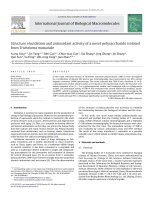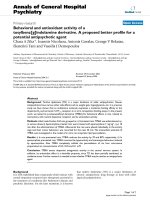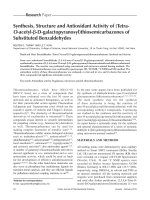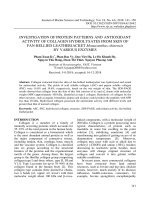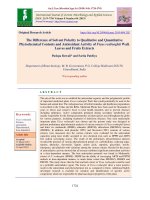Effect of thermal processing on quality and antioxidant activity of mixed Gac (Momordica cochinchinensis) - Papaya (Carica papaya) juice
Bạn đang xem bản rút gọn của tài liệu. Xem và tải ngay bản đầy đủ của tài liệu tại đây (177.17 KB, 5 trang )
Journal of Vietnam Agricultural Science and Technology - No.1(3)/2018
- e application of mulching materials in sesame
production in Nghe An increased plant height
from 65.2 - 74.8 cm on fertilizer level PB1 and 66.3
- 74.3 cm on fertilizer level PB2. e di erences of
fertilizer doses and mulching materials signi cantly
in uenced the number of owers/leaf axillary, in
which black nylon cover increased the number of
owers/axillary at the highest level, corresponding
to 4.0 owers in the PB1CP3 formula and 4.2 owers
in the PB2CP3 formula.
- By using of di erent cover materials, the bacterial
wilt resistance was at the highest level (Grade1). By
di erent covering materials, it also increased antidumping e ect, in which black nylon muching was
the highest (Point 1).
- e application of fertilizer level of 40 kg N + 120
kg P2O5 + 80 kg K2O + 200 kg of lime combined with
black nylon cover of 110 kg/ha or white nylon cover
of 100 kg/ha gave the highest yield of 1.4 tons/ha, up
40% compared to uncovered.
Recommendations
e application of fertilizer level of 40 kg N + 120 kg
P2O5 + 80 kg K2O + 200 kg lime powder combined
with black nylon cover of 110 kg/ha or white nylon
cover of 100 kg/ha was recommended for the summer
sesame production in Nghe An.
REFERENCES
Department of Crop Production, MARD, 2013.
Decision on recognition of new agricultural plant
varieties 83/QD-TT-CCN, dated on 7 March 2013.
F. Fazeli, M. Ghorbanli and V. Niknam, 2007. E ect
of drought on biomass, protein content, lipid
peroxidation and antioxidant enzymes in two sesame
cultivars. Biology Plantarum, 51 (1): 98-103.
Nghe An Crop Production and Plant Protection
Sub-department, 2016. Report on cropping and
plant protection in 2016, work plan 2017. Nghe An
Department of Agriculture and Rural Development,
No. 267/BC-TT on 20/12/2016, p. 5-11
Plant Resources Center, 2012. Form for evaluation
of sesame gene sources. Plant Genetic Resources
Assessment Form, Hanoi, p. 45-46.
Le Kha Tuong, 2009. Proposals for research on sesame
variety selection for drought resistant in Nghe An
province, ADB project, Hanoi.
Le Kha Tuong, Nguyen Trong Dung, 2013. Report on
research results and trial of sesame variety VD11.
Plant Resources Center, Hanoi.
Date received: 15/9/2018
Date reviewed: 23/9/2018
Reviewer: Assoc. Prof. Dr. Ninh i Phip
Date approved for publication: 25/10/2018
EFFECT OF THERMAL PROCESSING ON QUALITY
AND ANTIOXIDANT ACTIVITY OF MIXED GAC (Momordica cochinchinensis)
- PAPAYA (Carica papaya) JUICE
Nguyen Minh
uy*1, Ngo Van Tai1, Tran Quang Linh1, Nguyen
i Truc Ly1
Abstract
e experiment was conducted on a gac-papaya juice to determine the e ects of cooking conditions (open boiler
system and closed system) on product quality and antioxidant activity. e samples were subjected to cooking
for di erent lengths of time for each of the processing conditions. e main e ect of cooking condition (time,
temperature, type of cooking) was determined by using ANOVA. e physicochemical properties and antioxidant
activity of the product were measured. e physicochemical properties (Brix, pH and viscosity) of gac-papaya
juice changed signi cantly during heating time. e lycopene content signi cantly increased (p < 0.05) when the
period of boiling increased (at di erent cooking conditions) between 0 to 5 minutes. However, both the b-carotene
and the Vitamin C content decreased signi cantly (p < 0.05) as boiling period increased between 0 to 5 minutes.
Processing of juice in open boiler system led to a signi cant decrease in ascorbic acid and beta-carotene whilst
vacuum cooking preserved these compounds. e degradation of these compounds followed a rst-order model.
e antioxidant activity (AA) of these products (i.e. boiling in closed and open system) was also determined. In both
boiling conditions, signi cant increasing antioxidant activity was found.
Keywords: Antioxidant activity, boiled, gac, papaya, physicochemical properties
1
*
Department of Food Technology, College of Agriculture and Applied Biology, Can
Corresponding author: Nguyen Minh uy. Email:
o University
41
Vietnam Academy of Agricultural Sciences (VAAS)
INTRODUCTION
Gac fruit (Momordica cochinchinensis) has a potential
source of carotenoids, especially lycopene and betacarotene, that have proven to prevent cancer and
to even slow down the multiplication of cancerous
cells. Papayas (Caraca papaya) also contain healthy
antioxidants called carotenoids. ey are especially
high in a type of carotenoid called lycopene. ese
bene cial antioxidants are better absorbed from
papayas than from other fruits and vegetables
(Schweiggert et al., 2014). Antioxidants, including
the carotenoids found in papayas, can neutralize free
radicals, developing gac-papaya mixed juice with the
goal of providing an important source of nutrients
(pre-vitamin A and vitamin C) to support children’s
growth and disease prevention. Heat processing
of fruits and vegetables rich in lycopene makes
the availability of lycopene higher than in the raw
products (Donaldson, 2004). b-carotene is an organic
compound, a red-orange pigmented terpenoid
that abounds in plants. Vitamin C plays the role of
an antioxidant and acts to neutralize free radicals.
is present research aims at subjecting mixed gacpapaya juice to di erent heating conditions and
therea er evaluating the e ect of these treatments on
juice quality, especially the lycopene, beta-carotene,
vitamin C contents and AA of the product.
mixture was adjusted to 7.5oBrix, homogenized at
30 MPa for 6 minutes.
e samples were divided
into two parts and the heat treatment process was
carried out by two methods: open boiler system (pan
cooking) at boiling temperature and closed system
(vacuum 550 mmHg, evaporating temperature at
58 - 60oC for 5 minutes).
Analysis of physicochemical properties and AA for
products
Lycopene determination followed Fish et al. (2002).
Carotenes was determined by (Fikselová et al., 2008).
Vitamin C determination by Iodine titration (Alyea,
1969). Viscosity measurement by using a Brook eld
Viscometer and DPPH radical scavenging activity
was measure using method of Mensour et al. (2001).
Data analysis
e degradation rate of b-carotene and vitamin C can
be described by rst order reaction under constant
temperature condition.
ln (C) = ln (Co) – kt
MATERIALS AND METHODS
Where Co is the initial concentration of the quality
aspect, k is the degradation rate constant and t is the
treatment time. When the natural logarithm of the
residual concentration is plotted as a function of
treatment time, the degradation rate constant (k) can
be estimated by linear regression analysis. e k value
is derived from the slope of the regression line.
Sample preparation
Statistical analysis
Fruits (gac) were collected from An Giang province
and Can
o city (papaya). A er harvesting, gac
fruit was washed and the gac aril was separated. e
samples were kept in sealed plastic bags and frozen
at –18oC. Full ripe papayas were cleaned, peeled,
deseeded. ey were then made into puree through
blending for 20 seconds until a homogenous puree
was obtained. Pectinex Ultra SP-L (0.03% v/w) was
added into the homogenized papaya puree.
e
mixture was incubated for 40 minutes at 45°C and
then centrifuged at 100 rpm.
e enzyme in the
treated puree was deactivated at 95ºC for 2 minutes.
e lique ed papaya puree was then sieved by using a
cloth to yield an aqueous papaya extract.
Methods
Processing of gac-papaya juice
Gac fruit pulp and papaya juice were weighed at a ratio
of 1 : 1 (w/v). e obtained aqueous (papaya extract
and gac fruit) was then added with water at a ratio
of 1 : 10, then the mixture was ltered. e ltered
42
e data were subjected to a one-way analysis
of variance (ANOVA) and the signi cance of
the di erence between means was determined
by Duncan’s multiple range test (p < 0.05) using
STATGRAPHIC Centurion XVI so ware. Values
expressed are means of three replicates determination
± standard deviation.
Time and place of the study
e experiments were conducted in December 2016 to
July 2017, Department of Food Technology, College of
Agriculture and Applied Biology, Can o University.
RESULTS AND DISCUSSION
E ect of heating conditions on the viscosity, pH
and Brix content of the product
Statistical results showed that when the heating time
was increased from 3 to 5 minutes, the viscosity, pH
and soluble solid content of the product increased
signi cantly (Table 1). As the heating time increased,
the amount of water in the product was evaporated,
Journal of Vietnam Agricultural Science and Technology - No.1(3)/2018
thus increasing the density of the solute molecules
present in the solution, resulting in increased friction
between the slurry and the viscosity of the solution
increased. In addition, the amount of water evaporated
gradually increased with the heating time, the Brix
Table 1.
e viscosity, pH and soluble solid content of product at di erent heating system and time
Heating
system
Physico-chemical
characteristics
2
Open
heating/Pan
cooking
Viscosity (cP)
12.15
pH
Brix
Viscosity (cP)
pH
Brix
6.08a
7.27a
13.57a
6.08a
7.33a
Vacuum
heating
system
degree of the product increased. e increase in pH
value can also be explained by the decomposition of
vitamin C (which may be the main factor that makes
up the pH of the solution) by temperature (Johnson
et al., 2013).
Retention time (min)
3
3.5
4
2.5
a
12.93
14.53
6.11ab
7.53a
15.00a
6.16a
7.47a
6.21abc
8.13 b
28.17b
6.32 b
8.53 b
a
b
17.13
c
6.25bc
8.43bc
51.00c
6.38bc
8.73 b
20.47
4.5
d
6.28cd
8.60cd
68.47d
6.44cd
8.93 b
27.40
5
e
6.40de
8.67cd
92.87e
6.48cd
10.13c
29.20f
6.47e
8.93 d
108.40f
6.53 d
11.73d
Note: Values in the same column bearing di erent superscripts are signi cantly di erent (P < 0.05).
Effect of boiling conditions on lycopene,
beta-carotene and vitamin C content of mixed
gac-papaya juice
Lycopene
e lycopene of mixed juice are presented in Figure 1.
Two minutes boiling increased lycopene from 18.253
to 20.228 mg/ml. Extending the boiling time to 5
minutes further increased the lycopene to 29.234
mg/ml. e observed increase in available lycopene
content of gac-papaya juice as a result of boiling
(both in open boiler and vacuum system) was in
agreement with earlier reports (Dewanto, 2002). It
may be assumed that heating caused both pigment
degradation and an extractability increase due to the
breaking of protein-carotenoid complexes: in the skin
the rst e ect prevailed because of the thinness of
tissue, which allowed easy and fast heat conduction;
by contrast, in the pulp the lower temperatures
reached allowed the promotion of the breakdown
of protein complexes with lycopene, but not its
degradation (D’Evoli et al., 2013). ese results are
consistent with those from a study by Abushita et al.
(1997) on the e ects of technological treatments on
tomato carotenoids: analysis performed in raw and
thermally and mechanically treated (removal of seeds
and skin) salad tomatoes demonstrated that lycopene
extractability increased a er heating (+37%), while
β-carotene were partially degraded by heat (−29% and
−3%, respectively).
erefore, thermally processed
gac-papaya juice products could be the best food
sources of lycopene.
Figure 1. Changes of lycopene content in gac-papaya
juice a er cooking by di erent time and methods
Beta-carotene
Figure 2 shows the curve of b-carotene of heating
conditions at varied processing periods. e betacarotene content of juice decreased with increase in
time of boiling. ere was a signi cant (P < 0.05)
decrease in b-carotene content as a result of boiling
juice for 2 minutes and further decrease occurred by
extending the boiling time to 5 minutes (b-carotene
decreased from 1.892 to 1.512 mg/ml and from
2.658 to 2.259 mg/ml for boiling in open and closed
system, respectively). e degradation of b-carotene
followed rst order model and the degradation of
this compound as boiling in open boiler system was
faster (the k-value was higher) than in closed system
(vacuum cooking). is sharp decrease in b-carotene
content of the samples as boiling increased suggests
that b-carotene is a heat labile compound, and could
be more available in raw fruit than the processed
counterpart.
43
Vietnam Academy of Agricultural Sciences (VAAS)
Vitamin C
e vitamin C content of mixed gac-papaya juice
decreased as boiling time increased as shown in
Figure 3. Vitamin C of the product decreased from
17.013 to 5.867 mg/100 ml and from 18.187 to 7.627
mg/100 ml (in open and vacuum system).
Figure 2. Plot of ln(C/Co) versus heating time (min)
for b-carotene degradation during heating
(open boiler system and closed boiling system)
Figure 3. Plot of ln(C/Co) versus heating time (min)
for vitamin C degradation (open boiler
and closed boiling system)
Vitamin C progressively decreased as the processing
times increased therefore, suggesting that it does not
require excessive heat treatment.
e decrease in
vitamin C content was progressive as boiling time
progressed from 2 to 5 minutes and the degradation
of this compound followed rst order reaction. In
open boiler system, the degradation of this vitamin
was faster. ermal processing of product should be
carefully controlled to retain much of this vitamin in
the nal product.
Similar increases in AA were observed by Wang et al.
(1996) in heat-processed tomato juice and grape
juice compared with fresh products. Heating leads
to a slight increase in lycopene and thus directly
for the great increasing antioxidant activity of the
nal products. e conjugated double-bond system
of lycopene confers strong antioxidant activity
including the ability to quench singlet oxygen and
peroxyl radicals.
Processing e ects on AA of mixed gac-papaya juice
product
e AA of the product increased from 65.88 to
81.62% and 66.49 to 75.78% as open boiler and
closed vacuum heating, respectively when increasing
heating time from 2 to 5 minutes (Figure 4).
Figure 4. Changes of antioxidant activity
of gac-papaya juice during heating
at di erence heating system and time
44
CONCLUSIONS
Analyses were performed in this study leads to
understand the e ect of heating on physicochemical
properties of the fruit matrix.
e present study
especially provides the support for the bene cial e ect
of shorter heat treatment on lycopene availability of
gac-papaya juice. It is therefore, advisable to boil
before consumption for maximum absorption of
its available lycopene. e results also suggest that
lycopene in mixed juice may also be important
in conferring protective and antioxidative e ects.
However, excessive heat treatment would have adverse
e ect on the beta-carotene and vitamin C content of
mixed juice. is nutrition information could be a
guide for processors and consumers of gac products.
REFERENCES
Abushita, A.A., Hebshi, E.A., Daood, H.G., Biacs, P.A.,
1997. Determination of antioxidant vitamins in
tomatoes. Food Chem., (60): 207-212.
Alyea, H.N., 1969. Titration of vitamin-C with iodine.
Dem. 671. J. Chem. Educ., 46 (9), p. A634.
Journal of Vietnam Agricultural Science and Technology - No.1(3)/2018
D’Evoli, L., Lombardi-Boccia, G., Lucarini, M., 2013.
In uence of heat treatments on carotenoid content
of cherry tomatoes. Foods, 2, 352-363.
Dewanto, V.W., Adom, K.K. and Liu, R.H., 2002.
ermal processing enhances the nutritional value
of tomatoes by increasing total antioxidant activity.
J. Agric. Food Chem., 50: 3010-3014.
Donaldson, M.S., 2004. Nutrition and cancer: A review
of the evidence for anti-cancer diet. Nutr J., 3-10.
Fikselová, M., Šilhár, S., Mareček, J., Frančáková, H.,
2008. Extraction of carrot (Daucus carota L.)
carotenes under di erent conditions martina. Czech
J. Food Sci., Vol. 26 (4): 268-274.
Fish, W.W., Perkins-Veazie, P., Collins, J.K., 2002. A
quantitative assay for lycopene that utilizes reduced
volumes of organic solvents. J. Food Comp. Anal., 15,
309/317.
Johnson, O.R., Yetu, A.J., Oloruntoba, A.C., Samuel, S.,
2013. E ects of Nigerian market storage conditions
on ascorbic acid contents of selected tetrapak
packaged citrus fruit juice. Journal of Agricultural
Biological Science, 8 (2): 179-183.
Mensour, L.L., Menezes, F.S., Leitao, G.G., Reis, A.S.,
Dos Santos, T.C., Coube, C.S., 2001. Screening of
Brazilian Plant Extracts for Antioxidant Activity by
Use of DPPH Free Radical Method. Phytother Res,
15: 127-130.
Schweiggert, R.M., Kopec, R.E., Villalobos-Gutierrez,
M.G., Högel, J., Quesada, S., Esquivel, P.,
Schwartz, S.J., Carle, R., 2014. Carotenoids are
more bioavailable from papaya than from tomato
and carrot in humans: a randomised cross-over
study. Br J Nutr., 111 (3): 490-498.
Wang, H., Cao, G., Prior, R.L., 1996. Total antioxidant
capacity of fruits. J. Agric. Food Chem., 44, 701-705.
Date received: 28/9/2018
Date reviewed: 15/10/2018
Reviewer: Assoc. Prof. Dr. Nguyen Van anh
Date approved for publication: 25/10/2018
EFFECTS OF IMPROVED IRRIGATION TECHNOLOGIES ON YIELD
OF MANGO GROWN ON SANDY SOILS IN BINH DINH PROVINCE
Nguyen Tan Hung*1, Hoang Vinh1, Ho Huy Cuong1, Pham Vu Bao1,
Tran Dinh Nam1, Nguyen ai inh1,2, Richard Bell2, Surender Mann2
Abstract
Water is an important factor for mango production in Southern Coastal Central Vietnam (SCCVN). e experients
on the e ects of irrigation technologies on yield of mango crop on sandy soils were caried out in Binh Dinh province
with following treatments: (1) Irrigation based on farmer’s traditional practice; (2) Irrigation based on farmer’s
traditional practice following mini-pan; (3) Drip irrigation following mini-pan; (4) Sprinkler irrigation following
mini-pan. Resutls of study identi ed that the drip irrigation obtained the highest economic e ciency which increased
yield by 26 - 32%, saved 46 -70% amount of water and increased 45.7% pro t in comparison with the traditional
method. e irrigation following mini-pan also obtained high economic e ciency, this method increased fruit yield
of mango by 9 -14% and net pro t to 40 % while reduced 34 - 70% amount of irrigated water compared to the mere
farmer’s traditional practice.
Keywords: Water for mango, mini-pan, irrigation methods
INTRODUCTION
Southern Coastal Central Vietnam (SCCVN) has
a high potential to produce mango at di erent
times as compared to other regions of Vietnam and
hence has the potential to sell product at increased
market prices. However, with low rainfall which
is concentrated in three months in a year, causing
serious ooding while high evaporation rates during
the dry season results indrought. Irrigation from the
1
*
shallow groundwater can overcome drought, but for
coastal sandy soils, irrigation needs to be optimized
in order to achieve high mango yields but still save
water is very important for sustainable production of
on the sands of the SCCVN.
According to the statistic data (Binh Dinh Statistics
O ce, 2015), Binh Dinh province currently has
around 1,400 ha of mango orchards producing 5,400
tons of mango fruit with average yields of 4.15 t/ha.
Agricultural Science Institute for Southern Coastal Central of Vietnam; 2 Murdoch University, Western Australia
Corresponding author: Hoang Vinh. Email:
45
